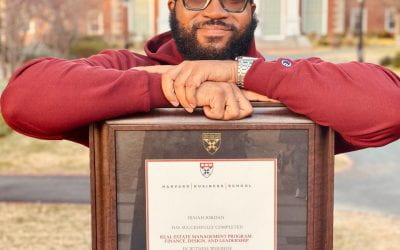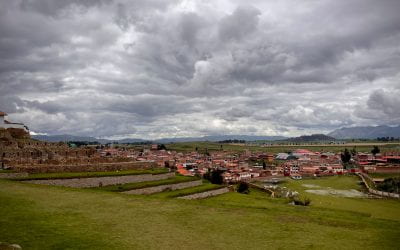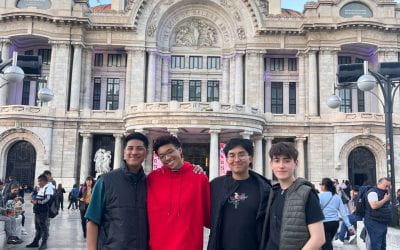
About the Author
Amiel Katz is a sophomore in Adams House studying social studies and global health. She centers her research on health policy, community-based healthcare and disability advocacy. Her article in the Lancet can be read here: https://www.thelancet.com/journals/lanam/article/PIIS2667-193X(23)00008-X/fulltext
Rare Diseases as Shared Experiences
Advocating for Health Access in Brazil, Peru and Colombia
Daniel Wainstock first messaged me in the summer of 2021. I had posted a photo of a boy in a wheelchair smiling from ear to ear while we were playing games out in the sun. Daniel thought it was wonderful that there was a program for helping disabled youth have fun. After exchanging a couple messages, Daniel asked me what organization sponsored my volunteering, which is when I introduced him to Camp M. I. Way.
At camp, we strived to create a fun and safe environment for children and adults with disabilities. Every person deserves the opportunity to form long-lasting friendships. Volunteers, like myself, would spend our summers ensuring the enjoyment of every camper. I educated many middle and high schoolers on how to engage with multiple impaired individuals. My volunteers learned how to actively listen to the diverse ways people communicate. As a rare disease advocate, Camp M. I. Way’s values resonated with Daniel. He wanted people living with rare diseases everywhere to have a safe, accessible environment like the one I helped create at Camp.
Having heard the story of how I got involved in disability advocacy, Daniel shared his. He told me about Eduarda, his close friend and classmate, who was diagnosed with cystic fibrosis, a disease that damages the lungs and digestive tract. Cystic Fibrosis is debilitating, meaning it causes a serious impairment of strength. Eduarda dreamed of being a lawyer like Daniel, but her disease made it almost impossible to continue her academic career. Daniel and Eduarda worked tirelessly to find a treatment option. Sadly, medical care for rare diseases is extremely difficult to access in Brazil.
After ardent advocacy, Eduarda connected with the University of Miami Cystic Fibrosis Center. She became a medical tourist and left her family to travel to the United States. Eduarda was treated with Trikafta, which helps correct protein malfunctions that cause cystic fibrosis. I find Eduarda’s story to be remarkable. She is one of the only Brazilians with cystic fibrosis to have this life saving chance.
Sharing personal stories is difficult. It takes courage and vulnerability. Yet, Daniel and I introduced ourselves with candor and sincerity. By sharing what made us passionate about our work, we established a strong foundation to our friendship. I realized the impact of our stories on each other and understood how impactful personal narratives can be.
There are 42 million people living with rare diseases in Latin America alone. More than 300 million people live with rare diseases worldwide. Despite this fact, public policies that support improving the health and livelihood of millions of people are lacking. Any one story might be rare, but collectively, people’s experiences share some similarities. Hearing personal narratives is imperative to helping shift the systems from isolating people with rare diseases to connecting them with each other.
Shared Narratives
When we first met, Daniel was studying law at PUC-Rio, the Pontifical Catholic University of Rio De Janeiro. He aimed to create policy to improve the overall well-being of people living with disabilities and rare diseases. I was just accepted into Harvard College and was actively advocating for the expansion of health rights in the United States. With our backgrounds in law, advocacy and health rights, Daniel and I set out to start a research project on rare disease policy in Latin America.
We wanted to write a paper that emphasized the importance of humanizing the law. We were inspired by Alicia Ely Yamin, a lecturer on law at Harvard Law School, and her ideology of policy creation. In one of her articles on Harvard Law School’s Bill of Health website, she writes, “decisions about rationing should not be made by technical experts behind closed doors, following opaque criteria that vary across hospitals, as is occurring now. Transparency, user involvement, and public deliberation about goals, principles, and guidelines for rationing are essential for trust and legitimacy in health systems and in our broader governments.” Her emphasis on including the public, especially directly affected populations, in public policy decisions helped formulate our research strategy. We set out to develop public policy recommendations to share with government officials by analyzing existing legislation and conducting interviews with people affected by rare diseases, as well as NGOs representing those with rare diseases in Latin American countries.
We started by reaching out to Diego Cardozo, the executive director of the National Rare Disease Federation of Colombia (FECOER). He works with local and national policy makers to improve access to healthcare for people living with rare diseases. Diego and FECOER drafted the Plan Decenal de Salud Pública (2012–2021), a public health plan which aims to promote health equity for the rare disease community. Over the years he’s worked in the rare disease space, Diego heard a multitude of stories. Every person shared their barriers to accessing healthcare and ideas on how to improve their well-being. Although each of their experiences were different, one thing remained constant. People lacked a platform to share their stories and needs.
Diego connected us to rare disease advocacy groups in Peru. We interviewed Maria Elena Almendarez Veiga, executive director of the National Rare Disease Federation of Peru (FEPER). She sent us a historic policy framework on rare diseases, as well as a timeline for future public health initiatives. FEPER’s resources greatly inspired our recommendations and sparked new ideas for our research. Through our interviews with FECOER and FEPER, we found incredible barriers to health access for people living with rare diseases. Daniel and I broke these barriers down into five categories: lack of access to diagnosis, diagnostic odyssey, lack of interest and transparency by pharmaceutical industries, right-to-health litigation and medical tourism and migration.
María Isabel Acevedo told her story of overcoming many of these barriers. María, a mother of two children with spinal muscular atrophy type 2 (SMA2), struggled to get her children diagnosed in Colombia. In the early 2000s, María’s first daughter started showing symptoms of SMA2. Unfortunately, Colombia didn’t have genetic counseling available, so María had to travel to the United States to get her daughter tested. When María’s second child was developing symptoms of spinal muscular atrophy, her doctors refused to believe her. Spinal muscular atrophy is caused by the autosomal recessive inheritance of the gene SMN1. This means that both parents must carry the gene. Since María’s children have different fathers, geneticists thought it was impossible that both her children inherited the same rare disease. It took more than a decade for the genetic tests to be confirmed.
New public health policies must be put in place to ensure that people living with rare diseases have access to their right to healthcare. No one should have to wait ten years for a single diagnosis. After analyzing existing public policies in Brazil, Peru and Colombia, as well as speaking with groups representing people with rare diseases and individuals living with rare diseases, we realized the disconnect with government officials in policy and the experiences of people experiencing rare diseases every day. Daniel and I set out to draft reasonable recommendations that would improve health access for all parties.
In order to increase access to healthcare for people living with rare diseases, the definition of a rare disease must be standardized and incorporated into a national or regional registry program. This will aid medical personnel with classifying, diagnosing and treating rare diseases. Moreover, there needs to be socio-economic assistance for both people living with rare diseases and their families. For example, a special pension for low-income, single mothers with children living with rare diseases can drastically change the living conditions for these families.
New Narratives
Our research has just been published in the Lancet Regional Health: Americas. Since publication, we have received personal messages about people feeling empowered to share their stories of living with rare diseases. The stories are waiting to be shared. There just needs to be a platform to amplify people’s voices.
I will continue to set up meetings with government officials, rare disease advocacy groups, people living with rare diseases and anyone who wants to share their story. I am positive that with increasing narratives and public sharing of stories, people will hear you. If you want your story to be shared, reach out to others, reach out to your politicians, and use your voice to make the change you want to see.
More Student Views
Resilience of the Human Spirit: Seizing Every Moment
In the heart of Chicago, where I grew up, amidst the towering shadows of adversity, the lingering shadows of generational demons and the aroma of temptation, the key to the gateway of resilience and determination was inherited. The streets of my childhood neighborhood became, for many, prisons of poverty, plundering, crime and poor opportunity.
Andean Cultural Landscapes in Danger: The Chinchero International Airport
English + Español
Cusco stands as one of the most culturally and ecologically captivating regions globally.
Blossoming Bonds: Beauty and Belonging in Mexico
When I heard the news about my upcoming trip to Mexico, a surge of excitement coursed through me, and I immediately felt the urge to share this exhilarating news with my close friends and family.




